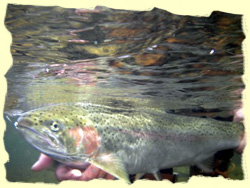Fly Fishing in California
 The Trinity River starts in the Trinity National Forest, and winds its way down to Trinity Lake, created by Trinity dam. Trinity Lake spills its water into Lewiston Lake, a long narrow lake that empties into the start of Trinity River. The town of Lewiston lies nestled in a beautiful little valley at the start of the river. From Lewiston Dam downstream to the Old Lewiston Bridge (approximately 1.5 miles) is the area that has been designated as the fly-fishing only water. It is mainly spawning grounds for Salmon and Steelhead and is closed to all fishing from Sept-March. The Trinity River starts in the Trinity National Forest, and winds its way down to Trinity Lake, created by Trinity dam. Trinity Lake spills its water into Lewiston Lake, a long narrow lake that empties into the start of Trinity River. The town of Lewiston lies nestled in a beautiful little valley at the start of the river. From Lewiston Dam downstream to the Old Lewiston Bridge (approximately 1.5 miles) is the area that has been designated as the fly-fishing only water. It is mainly spawning grounds for Salmon and Steelhead and is closed to all fishing from Sept-March.
 We fly-fish
from Lewiston Dam to the Hoopa reservation 90 miles
down river. There are two dozen access points on this
stretch of river where we fish from boats or from shore.
The Trinity River is known for its strong returns of
large adult Steelhead over a long season, often lasting
from September to March. It is not uncommon to catch
a rogue steelhead in the middle of summer. They average
in size from 6 to 8 pounds with an occasional fish
10 to 12 pounds. We fly-fish
from Lewiston Dam to the Hoopa reservation 90 miles
down river. There are two dozen access points on this
stretch of river where we fish from boats or from shore.
The Trinity River is known for its strong returns of
large adult Steelhead over a long season, often lasting
from September to March. It is not uncommon to catch
a rogue steelhead in the middle of summer. They average
in size from 6 to 8 pounds with an occasional fish
10 to 12 pounds.
When targeting
Steelhead We fish three different techniques. We drift
fish with indicators, which is one of the most effective
techniques. We use a weight forward floating line attached
to a straight leader 7 to 12 feet long. The leader
length should generally be one and a half times the
depth of the water. The set up is sometimes attached
with a lead shot 18 inches or so above the fly, suspending
the weight and fly below the indicator. An adjustable
strike indicator located at the top of the leader offers
easy visual detection of a fish’s grab, and the sporadic ticking of the bottom
The second more traditional method is swinging or skating flies through the riffles and tail outs with no indicator. I prefer this technique, especially when the fish are aggressive, as the grab is much more pronounced. We often fish with an egg and nymph dropper and high stick through the riffles, especially when the Steelhead are feeding on both insects and eggs. When fishing with indicators we cover more water, where as swinging and high sticking, we get out of the boat, slow down and die sect the water.
  The third
method is Spey fishing. With the introduction of the
shorter Spey and cross over rods (10-12 ft. 5wt - 6wt),
it now makes it possible to efficiently fish smaller
rivers. We generally swing leaches and nymphs using
this technique. The third
method is Spey fishing. With the introduction of the
shorter Spey and cross over rods (10-12 ft. 5wt - 6wt),
it now makes it possible to efficiently fish smaller
rivers. We generally swing leaches and nymphs using
this technique.
With the longer
days and warmer afternoons of February and March we
often get May and stonefly hatches. This gives us the
opportunity to catch Steelhead and browns on the surface,
which always makes a great end to the day.
Equipment
6 to 8 weight rods are preferred for Trinity Steelhead. My fist choice would be a 7wt. with a weight forward floating line. We often use intermediate or sinking tips lines for swinging the deeper riffles and pools. The advantage of using a floating line is the ease in which you can switch from indicators to swinging a fly, or switching entirely to a dry if desired. Sometimes it saves bringing an extra rod or spool. Neoprene or breathable waders and boots are a must as we are in and out of the boat a lot.
 The
boats we use are stable top of the line 16
ft. Boulder Boat Works drift boats with
level floors fly stands and bracing for ease
of casting.
We supply snacks, beverages and lunches on the
river. Bring your camera you will need it. Lets
go fishing! The
boats we use are stable top of the line 16
ft. Boulder Boat Works drift boats with
level floors fly stands and bracing for ease
of casting.
We supply snacks, beverages and lunches on the
river. Bring your camera you will need it. Lets
go fishing!
|